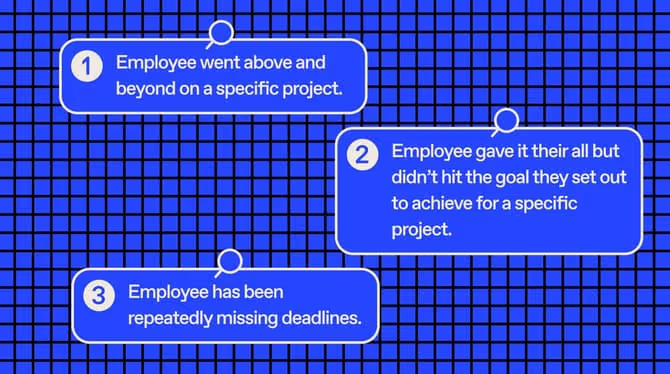Step-by-step guide to managing difficult conversations at work

Discover Workleap Officevibe's benchmark report on 12 key employee engagement metrics

Let's face it. Having difficult conversations at work is never fun. Whether it's about performance issues, workplace conflicts, or delivering tough feedback — these conversations can be uncomfortable. That said, being able to address sensitive subjects is an essential part of managing and supporting employees.
The good news is that tough conversations don’t have to be a dreaded part of a manager’s reality. In fact, with the right approach, they can create opportunities for growth and better communication. Grammarly’s The State of Business Communication report delivered the facts: 72% of business leaders believe that effective communication increases team productivity — and 52% of employees agree.
With more teams working remotely or in hybrid setups, effective communication has become more crucial than ever. The lack of face-to-face interactions can sometimes make misunderstandings more likely, so being able to handle tough talks skillfully is key to maintaining a strong, cohesive team.
If this speaks to you — you’re in the right place! Read on.
Scenarios of difficult conversations at work
Difficult conversations come in many forms, each with unique challenges. However, if managers can recognize the specific scenarios they’re dealing with, they can approach situations more effectively.
Here are some of the common situations managers encounter when it comes to tough talks:
Scenario 1: Performance issues
When an employee's performance doesn't meet expectations, it's crucial to address the problem promptly. This can involve discussing missed deadlines, poor performance, or a lack of initiative. It’s important to approach performance issue conversations with clear examples and a plan for improvement.
Scenario 2: Workplace conflicts
Conflicts between team members can disrupt the work environment and lower morale. Whether it's a clash of personalities or disagreements over work-related issues, addressing these conflicts early can prevent them from escalating. In these cases, managers should focus on mediation and finding common ground — and not hesitate to involve HR if necessary.
Scenario 3: Negative feedback
Providing negative feedback can be uncomfortable but is necessary for growth. The key is to be specific about the behaviors or outcomes that need to change and offer constructive advice on how to improve. Ensuring that the feedback is aimed at helping the employee develop their skills empowers them instead of demotivating them.
Scenario 4: Personal issues affecting work
Personal problems can affect an employee's performance and well-being. This happens to the best of us. These conversations require a high level of empathy and support. Depending on the situation, managers must be understanding and offer resources or accommodations that might help employees struggling to manage their personal issues while maintaining their work responsibilities.
Scenario 5: Career development discussions
Talking about career progression, promotions, or the lack thereof can be sensitive — especially if employee desires don’t quite match up with employer standards. The best way to manage expectations is by providing clear, actionable feedback on what is required for advancement. Highlighting the employee’s strengths and outlining a development plan will help them reach their career goals.
Scenario 6: Policy violations
Addressing violations of company policy, such as misconduct or ethical breaches, requires an immediate, straightforward, and firm approach. Managers must understand company policies and the potential consequences, and communicate these clearly during the conversation. In such cases, involving HR to assist can be a good idea.
There are, of course, a million possible scenarios that could warrant difficult conversations at work — some you may have already dealt with before. The more understanding you have around tricky situations, the better you’ll be able to anticipate and tailor your approach to ensure they’re handled the right way.
Manager’s guide: Five steps for tackling difficult conversations with employees
One-on-one meetings are a perfect setting for tough discussions between managers and employees. They provide a private, focused space to address sensitive issues — avoiding the employee feeling embarrassed or called out in front of their peers.
Here's a step-by-step guide to help you, as a manager, navigate these conversations smoothly and set the stage for a productive and solution-oriented one-on-one:
1. Prepare talking points in advance
Preparation is your best friend here. Let the employee know ahead of time what you want to discuss. This gives them a chance to prepare, rather than catch them off-guard, and ensures that the conversation is fair.
Pro tip: Instead of saying, "We need to talk about your performance," try, "I’d like to discuss some feedback and hear your thoughts on your recent projects. Can we chat about it in our next one-on-one?"
Meeting agendas help both parties prepare and align their thoughts beforehand. Check out our free one-on-one meeting agenda templates to plan your meeting — with suggested talking points!
2. Remain objective and focus on facts
Emotions can run high during difficult conversations. As a manager, your priority is to remain objective to the issue. To keep discussions productive, base your talk on facts rather than feelings. Gather data, examples, and even peer feedback to support your points.
Pro tip: Prepare your notes with specific examples. For instance, instead of saying something vague like: "You're not meeting expectations," say, "In the last quarter, you missed three project deadlines."
Ultimately, your goal is to address the issue objectively and constructively — not to make the other person feel attacked. A good trick is to consider the desired outcome (improvement) and build the conversation backward from that (the road to get there).
3. Create an environment for trust and honesty
Building a foundation of trust with employees is crucial for effective leadership. Regular one-on-ones and feedback loops can help employees feel more comfortable bringing up tough topics themselves.
Pro tip: Encourage openness by saying, "I want our one-on-ones to be a safe space where we can discuss anything, even if it’s uncomfortable."
Giving employees the floor to share their perspectives by prompting them with the right questions shows that you value their input. Make sure there’s always time for their insights at every one-on-one.
4. Aim for understanding above consensus
The ultimate goal when addressing a difficult situation isn’t necessarily to get everyone to agree. Rather, it's to reach a mutual understanding. Listen empathetically and give your team members space to share their perspectives so they feel like they are participating in the dialogue. This will invite more collaboration.
Pro tip: Don’t rush to defend your stance. Instead, listen actively and acknowledge their feelings, even if you don’t agree. Empathy is a powerful managerial skill.
Listening is another useful skill all managers should master, as it’s the fastest way to identify the root cause of issues and find solutions. Read our manager tips on how to become a better listener.
5. Find a solution together
At the end of the day, it’s about being able to provide negative feedback in a way that leaves the employee feeling empowered to do better. End the conversation with clear action items and next steps. Collaborate on a plan to move forward and make sure to follow up on progress during your next one-on-one.
Pro tip: Use Workleap Officevibe’s one-on-one software to set and track these action items. This ensures accountability and helps keep the momentum going.
Remember, there’s a difference between acknowledgment and agreement. You don’t have to completely align with an employee’s point of view to make them feel heard. People can agree to disagree and still come to a resolution.
Best practices for effective communication in the workplace
Good communication is the backbone of any strong team. Effective communication not only builds trust but also enhances team performance and job satisfaction. Here are some best practices to enhance your communication skills:
- Be clear and concise: LinkedIn’s Global Report found that 71% of hybrid and remote workers report higher rates of feeling left out due to overuse of jargon. So, a great rule of thumb is to keep messages clear and simple. This will help prevent misunderstandings.
- Practice active listening: Show that you’re engaged by nodding, summarizing their points, and asking clarifying questions. Active listening fosters mutual respect and understanding, making employees feel valued. HBR’s Are You Really Listening? is a great read for leaders to self-reflect on their own listening practices.
- Be empathetic: Understand where your team member is coming from. Empathy builds trust and openness, which are critical for effective teamwork. According to Businessolver’s State of Workplace Empathy report, showing your employees empathy is key to engagement and retention.
Clear and empathetic communication is the key to unlocking a team's full potential. Take a look at how e-commerce agency Irish Titan set their people back on track thanks to better communication systems!
Three icebreakers to get the conversation going
Starting a difficult conversation can be the hardest part. The trick? Using icebreakers can ease everyone into the discussion and make the process smoother. Here are some suggested icebreakers to get the conversation going:
“I’ve noticed a few things recently and would love to get your perspective on them.”
This opens the door for a two-way dialogue, making the other person feel included in the conversation. It encourages them to share their thoughts and feelings.
“Can we talk about some feedback I’ve received that might help us work better together?”
Framing the conversation around mutual improvement rather than individual criticism helps reduce defensiveness and promotes collaboration.
“I’m curious to hear your thoughts on how things have been going with [specific project/issue].”
Showing genuine interest in their perspective helps build rapport and can reveal underlying issues that might not be immediately obvious.
Icebreakers can transform a daunting conversation into a productive dialogue. They have the power to set up tough talks with a more empathetic context, which ultimately paves the way for more meaningful and effective communication.
Turning difficult conversations into employee performance improvement
Difficult conversations aren’t just about addressing issues — they’re opportunities for growth. And it’s really important to emphasize that with employees. These conversations can lead to significant improvements in performance and team dynamics.
Here’s how to use difficult talks to everyone’s advantage:
- Set clear expectations: Make sure your team member understands what’s expected of them moving forward. Clearly defined goals and standards provide a roadmap for improvement and accountability.
- Provide resources: Offer training, tools, or support to help them improve. This could include mentoring, access to educational materials, or even adjusting workloads to allow for focused improvement time.
- Follow up: Regular check-ins show that you’re committed to their development. Consistent follow-up not only tracks progress but also reinforces the importance of the improvements discussed.
By turning difficult conversations into constructive feedback sessions, managers not only address the problems at play but also create a culture of continuous improvement and support.
Looking for more tips? Make sure you’re caught up on the dos and don’ts of tough talks.
Handling difficult conversations at work with confidence: Leveraging technology for better outcomes
Handling difficult conversations can be a challenge — but it’s a crucial skill for any manager. By approaching these talks with empathy, preparation, and a focus on facts, you can absolutely turn them into productive discussions that lead to growth and improvement.
Not so scary anymore, is it? And with one-on-one meeting software, you can create a safe space for managing productive conversations. From agenda templates to objective setting and tracking, these tools help managers lead (and improve) team communication effortlessly through the good and bad.
Ready to enhance your communication skills? Check out Workleap Officevibe for more resources and tools to help you navigate difficult conversations and boost your team’s performance.
Give HR and managers the clarity, confidence, and connection to lead better every day.


%20(1).avif)


.avif)
.avif)








